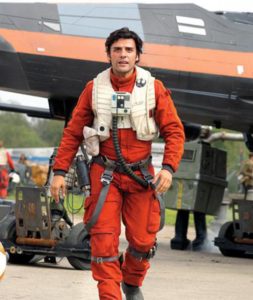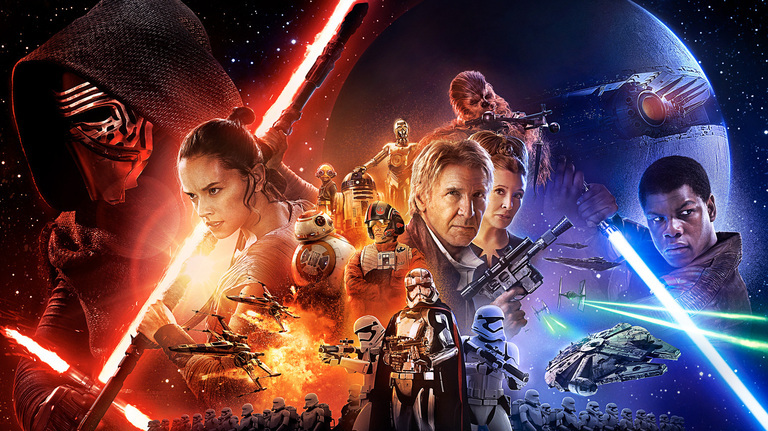‘The Force Awakens’ After Finally Finishing Its Beauty Sleep

Star Wars: Episode VII — The Force Awakens. A weighty title for an overdue installment in the most culturally significant spec-fiction saga of our era.
We don’t even need to look past the numerical designation to get a sense of the terror director J.J. Abrams claims to have experienced upon assuming the burden of such an undertaking. How do you succeed a six-film cycle that managed to conclude with definitively-cathartic finality? Abrams, veteran rebooter of hallowed franchises, initially passed on an offer to direct the first Star Wars film commissioned by Disney after it bought Lucasfilm for $4 billion in 2012. There were too many expectations attached to the project; too many ways to screw the whole thing up. The question that finally convinced both Abrams and Lawrence Kasdan — screenwriter of The Empire Strikes Back and Return of the Jedi — to reconsider signing on was a deceptively simple one: “Who is Luke Skywalker?”
It’s not the who of Luke but the where that drives the plot of The Force Awakens. The last Jedi, shaken by tragedy, has disappeared, and in so doing sucked the whole galaxy into the vacuum of his absence. The fledgeling New Republic and its Resistance forces — led by Carrie Fisher’s dignified General Leia — race the Nazi-esque legions of the diabolical First Order in search of a map that will guide the way to Skywalker’s mystery retreat.

BB-8 and Rey (Daisy Ridley) behold a surprise.
Custody of this plot device has been bequeathed to BB-8, a roly-poly astromech droid with a distinctively canine personality and a vocabulary comprised more of buzzes than beeps. Abandoned on Jakku, an interchangeable-with-Tatooine desert world, the droid sets out to return the map to the Resistance. There ensue sneak attacks, narrow escapes, abductions and pursuits galore, buoyed by the breathless piping of John Williams’ original score, during which an all-the-more-likely-for-being-unlikely alliance is formed between stormtrooper-with-a-conscience Finn (John Boyega) and scavenger-with-a-past Rey (Daisy Ridley). Their organic banter, harried sniping, and repressed romantic tension recall a young Han and Leia on the run.
Hot on their heels is evil’s new enforcer: the black-masked, rumbly-voiced Kylo Ren (Adam Driver), a villain I don’t hesitate to place beside — or even (gasp!) above — Darth Vader. Whereas Anakin Skywalker fought futilely to resist the dark side of the Force in the depths of his own heart, Ren fights against the light side as against a virulent temptation. This makes him both more and less vulnerable than his predecessor, whom he venerates. Vader was always driven by loyalty; he fell out of fear for his wife, and rose out of love for his son. Ren’s darkness, on the other hand, is ideological. And a terrible darkness it is. There are no poor performances in this film, but the menace exuded by Ren is outsized, his scenery-chewing (at times literal, as when he receives bad news) an ever-looming threat to our ragtag heroes. Much has been entrusted to the cast’s newcomers, and they each step up in a big way.

Chewbacca (Peter Mayhew) and Han Solo (Harrison Ford) are both shocked as an enemy approaches.
And of course there’s also the old guard. Harrison Ford is back as Han Solo, slipping on the snide smuggler’s holster with ease, his twisted grins and verbal barbs feeling like broken-in boots that’ll never get old. The writing here is really quite good, the dialog occasionally reaching Empire Strikes Back heights. But this time, Solo isn’t along just for the laughs. The part he must play is one of deep significance — indeed, it wouldn’t be an exaggeration to say that he is the soul of this film, the emotional lynchpin. Kasdan has said that what interests him most about the characters he helped shape forty years ago was how they’d responded to the vagaries of time. Han Solo may be the same scoundrel we all remember, but his role has grown.
And what of Luke, you ask? Ah, but that’d be telling. I have as much to say of him as did the trailers: nothing.

Poe Dameron (Oscar Isaac) finds an unknown something.
I’ve seen the film twice now. The first viewing left me emotionally exhausted in a way I hadn’t really experienced since The Fellowship of the Ring. I felt weary, as though I’d just run a gauntlet. The first two acts of The Force Awakens constitute one long chase sequence, and the First Order’s doggedness leaves scant space for breath-catching. In addition, the second act suffers from overly-aggressive editing that crams a whole lotta plot into as little time as possible. The result was that I, to my alarm, felt myself slowly detaching from the story before the final act swooped in to pierce my heart and stick the landing in spectacular fashion.
But upon my second viewing, the editorial irritants seemed to vanish. The action was more fluid, the pacing more even. Even the dialog came off as funnier. Aside from a couple of plot holes that would’ve likely been filled by deleted scenes, the whole movie felt like classic Star Wars through and through. Perhaps my initial annoyance was due to a discrepancy of expectation.

Finn (John Boyega) is marooned in such-and-such a place.
It goes without saying that Abrams has rejected the gleaming CGI chrome of the Star Wars prequels in favor of physical sets and the grunge of a beat-up and worn-out galaxy, an environment that not only looks like it could actually work, but like it’s stopped working and been under repair since forever. We all expected that — but what’s impressed me about Abram’s approach to The Force Awakens is the stinginess with which he parcels out information. I’ve seen the film criticized for its structural similarities to A New Hope (as though The Phantom Menace, the series’ previous respawn-point, didn’t rely on the same formula), but The Force Awakens bears a more important resemblance to The Empire Strikes Back: it sets up real mysteries heading into the next film. There’s so much here that, to Abram’s credit, simply isn’t explained — a lot of payoffs we’ll need to come back to enjoy. This is very much the first leg of a journey with the potential to go deeper and grow more complex than even the original trilogy.
But the greatest accomplishment of The Force Awakens may be that it gives us something that we, as a culture, haven’t experienced before in any Star Wars film — the sensation of watching A New Hope as though it’s actually “Episode IV” instead of a de facto “Episode I.” Pretend for a moment that the prequels were as good as the original trilogy, and then imagine walking into A New Hope for the first time with the emotional attachments cultivated by three previous films. That’s what it’s like to watch The Force Awakens; it’s a new take on A New Hope with way more emotional resonance.
After thirty-two years of living in the past, the Star Wars saga has finally taken its next step into a larger world.






































Good review. It was interesting how the movie got Luke and Leia more-or-less out of the way, and let Han and Chewie and the Falcon serve as the main bridge between the old and new. I can’t say I’m quite prepared to put Kylo Ren above Darth Vader, though, or at least the mature Vader of the original series. Ren still came off more like a hot-tempered brat at times, he didn’t have the cold, robotic-like menace that Vader often had.
Yes, Vader was cold and calculated, and Ren is an insecure fanatic prone to tantrums. But I already hate him more than I ever hated Vader, because he was willing to break Vader’s one rule (the nature of which is a major spoiler) out of ideological commitment to the dark side. In that sense, he’s already surpassed Vader in my mind. I can’t envision a scenario in which Ren gets redeemed; if that’s what’s in store for the character, it’ll take some insanely good storytelling to get there. And in the meantime, I just want him dead. Which is always a good sign for a villain.
Speaking of the dark side, and that hologram of Stope, or Snope, sorry I’m not remembering that name very well, but it did cause one thought to come to my mind…
The One Ring wasn’t completely destroyed, Gollum wasn’t really killed, and after tens of thousands of years, he’s become powerful enough to get his revenge. Which means…somehow, the Skywalkers are descended from the Bagginses. Not sure how that last part works, I admit.